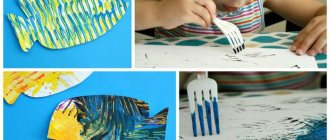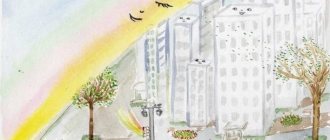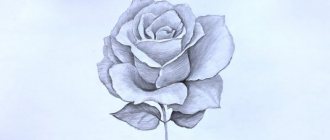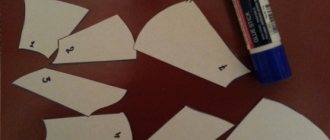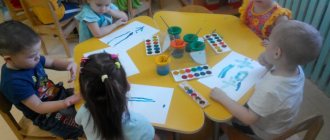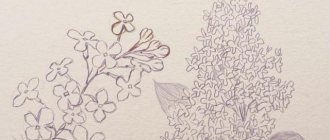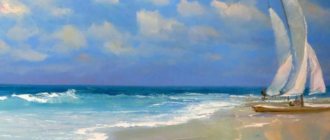Progress of the lesson.
Children sit in a semicircle on chairs. An audio recording of a song from the cartoon “The Adventures of Captain Vrungel”
.
The teacher brings Captain Vrungel (a toy) into the group room, speaks for him.
Captain Vrungel. I wish you good health, children! I, Captain Vrungel, have heard a lot about how kind and skillful you are. I had a misfortune and I want you to help me .
Educator. What happened to you, captain?
Captain Vrungel. During a storm, my favorite yacht “Trouble”
sank.
Now I am a captain without a ship and cannot continue my voyage.
Educator. Don't be sad, captain, we will definitely help you. Just explain what kind of ship ?
Captain Vrungel. Strong, reliable and beautiful, in general, like my “Trouble”
.
Unfortunately, only this photograph remains from her (shows the picture)
.
Educator. Well, guys, let's help Captain Vrungel? Shall we draw him a sailing ship so that he can continue to sail the seas and oceans?
Children. Yes, we'll draw it.
Educator. Then let's go to the tables and draw Captain Vrungel his ship . And you, dear captain, sit with us and watch how the kids try .
Educator. Before you start drawing a sailing ship , I will teach you guys how to do it (comes to the easel, shows drawing techniques)
. First we draw the deck, don’t forget about the sail and flag. You can draw portholes. Well, shall we get started?
Children draw contour images of ships .
Educator. Before you start painting ships, you need to rest.
Captain Vrungel. I suggest you swim a little. This is good for your health and very pleasant.
How nice it is to swim in the river! (perform circular movements with hands)
Bank on the left, bank on the right, (turn the body left and right)
The river is a ribbon in front, (stretch arms in front)
There's a bridge on top - look (raise their hands up)
We row quickly with our hands.
Who will keep up with us? (perform circular movements with hands)
.
And now it's time for us, brothers,
Lie on the sand.
We are crawling out of the river (they are marching in place)
And we relax on the grass (they sit at tables)
.
Captain Vrungel. Now you can start painting the ships . They must be beautiful.
Children color outline images with paints .
Captain Vrungel. How to choose the most reliable and fast ship? It is necessary to carry out tests by launching the ships into the water . It will immediately become clear whether they can withstand the difficult voyage.
Educator. Watercolor paint will help us launch ships Take your brushes and use loose strokes to paint the sea.
“The Sound of the Sea” is playing
. Children tint the bottom of the sheet with watercolors.
Educator. You see, captain, how confidently our ships ! Well done guys today, they did their best !
Captain Vrungel. The ships turned out like real ones. I immediately smelled the fresh sea wind. How easy it is to breathe! I really like all sailboats. But how to choose the best one?
Educator. Children, let's place all the drawings on the stand. Maybe your parents will help Captain Vrungel choose a suitable ship for sailing ?
Captain Vrungel. Right. And I'll go get ready to sail. In gratitude for your efforts , please accept these sea stickers from me (gives stickers and leaves)
.
Synopsis of an integrated lesson in visual arts for the senior group on the topic “Our City” Summary of educational activities in visual arts. Drawing on the theme “Our city”. Annotation. The topic of the lesson “Our City” is relevant in education.
Summary of the lesson on visual arts “Firebird” for children in the preparatory group Goal: To develop interest in visual arts. Objectives: Develop moral qualities (responsiveness, kind attitude towards people);
Summary of an open lesson in visual arts in a non-traditional way for children of the junior group “Butterflies” Summary of an open lesson in visual arts in a non-traditional way for children in the junior group. Topic: "Butterflies". Goal: learn to draw.
Summary of a lesson in visual arts for children in the middle group “Autumn” Summary of a lesson in visual arts on the topic “Autumn”. prepared by additional education teacher Evgenia Vladimirovna Chumova.
Summary of a lesson in visual arts for children of the preparatory school group "Golden Khokhloma" Summary of a lesson in visual arts for children of the preparatory group for school Topic: "Golden Khokhloma" Program objectives:.
Summary of a lesson in visual arts for the senior group “Dandelion” Goal: to develop children’s ability to draw dandelions using the poking method (painting with a semi-dry hard brush). Objectives: 1) educational:.
Summary of a lesson in visual arts “Ice drift on the river” for children in the preparatory school group. Program content. 1) Learn to create a landscape composition, depicting ice drift on the river. 2) Expand children’s knowledge about ice drift. 3) Fasten.
Summary of an educational lesson with elements of visual activity for children of the middle group “Our toys” Goal: to continue to develop the ability to examine objects, highlighting their signs, qualities and actions, to compose together with the teacher.
“The boat is sailing” - artistic work in the preparatory group (3-dimensional paper craft with origami elements) Artistic work in the preparatory group (3-dimensional paper craft with origami elements) Purpose: To develop cognitive, constructive,.
Lesson on the development of the lexico-grammatical structure of speech for children 6–7 years old with ODD “The boat floats, sails...” Lesson on the development of the lexico-grammatical structure of speech for children with ODD. Direction of activity: “Cognitive. Social and personal."
Source
Preview:
State institution Uraysky specialized “Children’s Home”
KHMAO - Ugra. Educator: Shestakova O.I.
Summary of an integrated lesson for children of the first junior group (drawing) “Boat”.
Goal: To introduce children to a new type of transport - a ship.
Integration of educational areas:
"Reading fiction"
• Introduce children to a new type of transport - a ship;
clarify and activate children's speech using nouns denoting types of transport (bus, car, boat, and also enrich children's vocabulary with nouns (ship, sail, sailboat);
• Learn to look at a drawing - an illustration, tell with the help of the teacher what is drawn in the picture.
• Develop the psychological basis of speech: attention, memory, thinking;
• Continue to develop communication skills: listen carefully to the teacher and answer his questions, develop communication skills not only with adults, but also with peers.
• Continue to develop the ability to listen to poetic text;
• Continue to improve your ability to work with paints, practice drawing wavy lines.
• Develop the ability to listen to the teacher and your comrades;
• Cultivate emotional responsiveness.
Preliminary work: familiarization with land transport (bus and car) and water transport (boat): looking at books, illustrations, reading works of art, playing with story toys, active, didactic.
Materials and equipment: pictures depicting a bus, a car and a boat, a toy boat, a drawing of a sailing ship at sea, a flat figurine of a paper boat, a phonogram of the song “Boat”, music. A. Pinegina, lyrics. D. Kharms, 6-8 boats for playing - experimenting, 2-3 basins with water, an easel, paints, brushes, album sheets (for each child, glasses with water, a sheet of Whatman paper size A3.
I. Organizational moment and introduction to the topic of the lesson.
V. – Guys, when you and I need to go somewhere in the city, what kind of transport can we use?
Children: by bus, by car.
V. – Yes, in the city you can travel by car or by bus.
(Teacher shows pictures)
II. Main part. Getting to know the sailboat.
V. – What if we need to cross the river? What transport will we use to do this?
V. – Yes, here we need a boat (shows a picture)
V. – But you can only cross the sea, where the wind raises high waves, on a large ship. Here, for example, on this one (shows a boat).
V. – As you can see, this is not a simple boat, it has a sail and it’s called a sailboat.
- What is it called? (Sailboat) (individual and collective responses of children)
Sailboat game.
Let's stand in a friendly circle and look at the sailboat.
Q: Do you want to hold a sailboat? (Yes)
-Take, Ilya, please, the boat.
The teacher hands the child the boat.
Q: - Now give the boat to Amina and say: “Please take the boat, Amina.”
“And Amina will tell you: “Thank you, Ilya!” »
Next, the children pass the boat in a circle to each other using the above phrases. The ship returns to the teacher.
Q: — The wind blows in the sails, and the ship floats where the man directs it.
I know a poem about a sailing ship.
The wind blows across the sea
And the boat speeds up;
He runs in the waves
With full sails...
V. – And I also have such a beautiful painting.
The teacher shows a picture of a sailboat.
— Show me where the sea is drawn in the picture?
-What color is it? (Children's answers)
— Tima, show me the waves in the picture?
- Where is the boat sailing among the waves?
-Where are the sails of the boat?
III. Game-experimentation with a boat.
V. – I also have these boats. How about you and I also try to launch our boats on the water?
V. – But in order for our sailboat to sail, we need wind. You and I will now turn into little breezes.
-We spun, we spun, we turned into little breezes!
The teacher and children blow on the sails and the boats move.
Then you can blow on the water, making waves.
IV. Musical and rhythmic movements.
V. – This is how our sea got raging! But the sailors on the ship were not afraid and swam to the shore.
A song will tell us who sailed on this ship with the sailors.
(Children and teacher dance to the song “Boat”)
V. - Guys, of course, you guessed who sailed on the ship?
V. Drawing the sea.
V. – And I also have this boat. My boat cannot sail in the sea, because it is made of paper. It requires not an ordinary sea, but a painted one.
Let's all draw a huge sea for him together.
To paint the sea we need to take paint.
— What color should the paint be?
Children: Blue, blue.
V. – The sea is correctly painted with blue paint.
V. – Today we will draw the sea, on which the wind raises high waves
(The teacher on the easel shows techniques for drawing waves).
V. – This is the sea I got.
— Show how you will draw waves.
Children draw wavy lines in the air with their fingers.
- Now paint the sea with paints.
Children draw, the teacher helps children who have difficulty.
The drawings are displayed on the stand.
V. – What a huge sea we painted! - Who remembers the name of a ship with a sail?
V. – Now the sailing ship can sail for a long time on the blue sea.
The teacher shows how a paper boat floats on the waves, then gives the children the opportunity to play with it.
Techniques and techniques used
Students in the middle group begin to work with scissors - they learn to cut parts in a straight line, as well as round corners. To create the look of a boat, you need to cut the corners on one side so that the rectangle turns into a trapezoid.
The preschooler's task is to cut off the corners of a rectangle so that it turns into a trapezoid
If the boat is supposed to have a sail, it can be designed in the form of a triangle or semicircle. In the first case, the child cuts a square diagonally, in the second option, the resulting part needs to round the corner, turning it into a semicircle.
To create a sail, the child will need to cut a triangle from a square, and then transform this figure into a semicircle
A semi-oval can also be obtained by cutting off the corners of a rectangle.
You can make a sail from a rectangle, turning it into a semi-oval
First, the teacher clarifies the shape of each part and demonstrates a sample. Children move their hand along the imaginary outline of an object in the air.
The finished boat can be decorated with a flag (triangle).
The finished compositions in the traditional version look something like this
When all the details are cut out, the teacher pays attention to the composition, discusses with the children how to beautifully arrange the boat on the base, depending on their number - one, two or three. After this, the skills of careful gluing are practiced: you need to apply the glue with a brush carefully, in a small amount, with the part being positioned with the colored side down.
Video: boat made of geometric shapes (process of application)
Unconventional applique
You can depict boats floating on the river not only using traditional techniques. Preschoolers can successfully use cut-out appliqué by creating an image from small pieces of randomly sized paper that are torn off by hand.
You can depict a boat using the broken applicative technique
Alternatively, this method can only depict a river or lake.
In the breaking technique you can only depict water
An interesting idea is to make a boat using the origami technique. You need to take the simplest option, when the image is obtained by folding a square and bending its edge. And the work will be complemented by waves from a satin ribbon (the child can easily glue it on, following the teacher’s instructions).
A sailboat can be made very easily using the origami technique, and waves made from satin ribbon will make the composition even more original
Unusual waves can be created from pieces of crumpled napkins. To do this, it is torn into small pieces, and lumps stick together. Another option is to crumple the napkin with your hands to form a flagellum, and then unfold it a little and glue it.
Interesting waves can be made from a crumpled napkin
A similar method is good for depicting clouds in the sky (cotton wool is also suitable for this).
Video: a boat with voluminous sails, sea foam made of cotton wool (the parts are prepared by an adult, and the child glues them on)
What can be added to the application?
Additional visual techniques will help you create an original composition of boats. So, the waves that rock the boat can be painted with watercolors or brighter gouache.
Waves can be painted with watercolors or gouache
Plasticineography also goes well with applique. Thus, plasticine can be used to represent the mast and portholes of a boat, as well as sea waves and a bright yellow sun in the sky.
Applique and plasticineography complement each other perfectly
On the topic: methodological developments, presentations and notes
Teach children to construct crafts from natural materials, connecting parts with pieces of plasticine. Develop imagination, attention, perseverance.
Summary of the integrative lesson “Swim, sail, boat!” (middle group) Purpose: To introduce children to the fact that there is air inside a person, to discover it, air leads.
Graduation evening in the preparatory group.
information for parents "BOAT OVER THE CITY".
The plan is a summary of directly educational activities with children of the senior group in the educational field of “Cognition” (experimental activities, design).
Direct educational activities (DEA) for children are based on V. Suteev’s fairy tale “The Ship” with watching a cartoon and subsequent conversation about ways to depict characters.
Summary of direct educational activities Topic: A. Barto's poem "Boat". Elemental experience activity "Boat made of paper". Games with boats in the water. .
Source
Outline of the drawing lesson “Ship. Familiar form - new image" in the younger group
Victoria Gunkina
Outline of the drawing lesson “Ship. Familiar form - new image" in the younger group
Topic: “Ship. Familiar form - new image"
Goal: To develop children's creative abilities in visual arts; the ability to transform familiar forms into a new image (Non-traditional image technique: drawing with the palm of your hand, then by drawing it into something else (a boat).
Tasks:
1. Create a joyful, emotional mood.
2. Consolidate knowledge about water transport.
3. Foster interest and love for art; cultivate aesthetic taste; accuracy.
4. Fix the names of colors (yellow, red, blue, green).
5. Develop spatial thinking, imagination, fantasy and creativity.
Materials: paints, jars of water, white paper, brushes, oilcloths, napkins, sample drawing.
Preliminary work - conversation on the topic: transport (water transport)
Progress of the lesson:
1. Show illustrations on the topic of water transport; conversation.
2. Finger game. The boat floats along the river, leaving rings on the water. We connect the palms of both hands with a “boat” and make sliding movements along the surface of the table.
3. Invite the children to draw a boat in an unusual way - using their palms.
1. Sample showing.
2. Explanation of the technique, demonstration by the teacher.
3. Children doing the work. During the “finishing” process, the teacher provides individual assistance. Let's look at the names of the colors. To make the work more colorful and interesting, we added a few touches (sun and sea).
Final part:
What they were doing? Liked?
The children, with the help of the teacher, put together an exhibition from their drawings.
Abstract of GCD on application in the junior group “Ship” Goal: To develop the ability in children to perform an application from ready-made elements, consisting of several parts. Objectives: Continue to teach children.
Summary of a lesson on application in the second junior group “Ship for Aibolit” Objectives: to demonstrate positive emotions in children when perceiving a familiar literary work; gluing in accordance with the sequence.
Summary of a lesson on FEMP in the junior group “New Year at the Gates” Summary of direct educational activities on FEMP in the second junior group Topic: “New Year at the Gates”. Objectives: • Learn to compare.
Notes for a math lesson in the second junior group “Size, shape, color” Notes for a math lesson Task: To give the concept that objects can be different in size, shape, color. Goal: - Learn to compare.
Outline of a lesson on drawing in a non-traditional technique of imprinting “Autumn Tree” for the second junior group GCD Outline of a lesson on drawing in a non-traditional technique (imprint) “Autumn Tree” for the second junior group (3-4 years old) Goals and objectives:.
Outline of a drawing lesson “Let's decorate a house mitten” in the junior group Artistic and aesthetic development. Drawing. Topic: “Let’s decorate a mitten - a house.” Goal: to develop the ability to decorate an object in an unconventional way.
Outline of a lesson on drawing in a non-traditional technique (waxography) “Fish” for the first junior group (2-3 years old) GCD Outline of a lesson on drawing in a non-traditional technique (waxography) “Fish” for the first junior group (2-3 years old) )Goals and objectives:.
Outline of a drawing lesson in the middle group Drawing with paints on the theme: “Autumn has come.” (teamwork) Pedagogical goals: To teach children to reflect the signs of autumn in a drawing.
Outline of a lesson in the middle group on drawing using non-traditional techniques “Winter. Winter patterns" Municipal budgetary preschool educational institution "Kindergarten of general developmental type No. 83" of the Samara city district.
"Canning fruit." Outline of an open drawing lesson in an early age group Outline of an open drawing lesson in an early age group on the topic “Home canning” Goal: development of creative and cognitive skills.
Source
Theme of the week: “Winter”
Lesson 14. Winter landscape
(Brush painting. Gouache)
Program content. Start introducing children to the landscape. Learn to draw winter trees with the whole brush and the tip of the brush. Learn to draw a contrasting winter landscape using white and black gouache. Develop imagination, emotional and aesthetic feelings, love for nature.
Material. Reproductions of paintings depicting a winter landscape. Blue or gray sheets of paper, gouache, brushes, jars of water, rags (for each child).
Progress of the lesson
Tell the children that when an artist paints nature, he is depicting a landscape. Ask what the artist can draw. (Sea, mountains, forest, river, lake, street with trees, etc.)
Read B. Kapetyan’s poem to the children:
Snow-white, white-winged
Our winter is winter,
I whitewashed everything diligently:
Both trees and houses.
Invite the children to draw a landscape - a winter street with trees and bushes. Ask what colors can be used to represent trees, bushes and snow. Tell me that trees can be painted with black paint, and snow with white paint.
Invite each child to draw black trees in the form of pillars expanding downwards with thin branches diverging in different directions and bushes consisting of branches. When the paint dries, paint white snow and falling snowflakes around with the tip of a brush.
Theme "Pets"
Lesson 18. Filimonov horse
(Drawing with felt-tip pens)
Program content. Cultivate interest in the works of folk artists. Teach children to paint the silhouette of a Filimonov toy, alternating straight stripes of two colors (green and red).
Material. Clay Filimonov toys and illustrations with their images (young ladies, soldiers, horses, deer, ram, birds); samples of elements of Filimonov painting. Silhouettes of Dymkovo horses cut out of yellow paper, felt-tip pens or colored pencils (for each child).
Progress of the lesson
Tell the children that in the village of Filimonovo they made toys-whistles from white clay for the holidays - animals, birds, horses, ladies, soldiers.
Show the children the Filimonov horse and pay attention to its features: the horse, like all Filimonov toys, has a very elongated neck and a small head. The horse is decorated with narrow stripes of green and crimson (red), in the center there is a flower consisting of rings of the same colors.
Invite the children to become Filimonov masters and color horse silhouettes cut out of yellow paper with alternating stripes of red and green.
The result was festively painted Filimonov horses.
